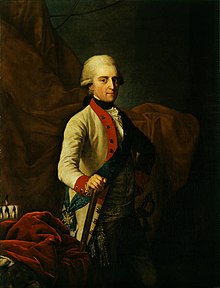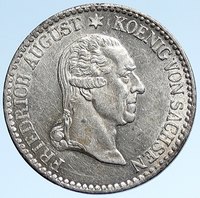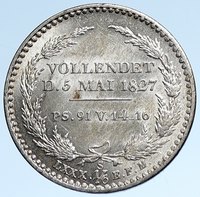Germany - German States. Kingdom of Saxony under Anton I (1827-36)
Death of Frederick Augustus I
King of Saxony: 20 December 1806 - 5 May 1827
1827 S Silver 1/6th Thaler 23mm (5.34 grams) 0.521 Silver (0.0894 oz. ASW)
Reference: KM# 1107 (1827)
FRIEDRICH AUGUST *KOENIG VON SACHSEN, Friedrich facing right.
VOLLENDET D.5 MAI 1827 PS.91 V.14-16 LXXX 1/6 E.F.M., Memorial Wreath. You are bidding on the exact item pictured, provided with a Certificate of Authenticity and Lifetime Guarantee of Authenticity.
 Frederick Augustus I (German: Friedrich August I.; Polish: Fryderyk August I; 23 December 1750 – 5 May 1827) was a member of the House of Wettin who reigned as the last Elector of Saxony from 1763 to 1806 (as Frederick Augustus III) and as King of Saxony from 1806 to 1827. He was also Duke of Warsaw from 1807 to 1815. Frederick Augustus I (German: Friedrich August I.; Polish: Fryderyk August I; 23 December 1750 – 5 May 1827) was a member of the House of Wettin who reigned as the last Elector of Saxony from 1763 to 1806 (as Frederick Augustus III) and as King of Saxony from 1806 to 1827. He was also Duke of Warsaw from 1807 to 1815.
Throughout his political career Frederick Augustus tried to rehabilitate and recreate the Polish state that was torn apart and ceased to exist after the final partition of Poland in 1795. However he did not succeed, for which he blamed himself for the rest of his life. Nevertheless, his efforts at reestablishing an independent Polish nation did endear him to the Polish people. The Augustusplatz in Leipzig is named after him. Frederick Augustus was the second (but eldest surviving) son of Frederick Christian, Elector of Saxony, and Maria Antonia Walpurgis, Princess of Bavaria, of the House of Wittelsbach. Because he was underage at the time of his father's death in 1763, his mother served as Regent until 1768. His uncle Prince Francis Xavier functioned as his representative. Through his father's side, he was descended from two kings of Poland, and through his mother's side, Siemowit, the first confirmed duke of Poland. In 1765 Prince Francis Xavier ceded the Polish throne to Stanislas II Augustus on behalf of the underage Elector. However, when a Polish Constitution was ratified by the Polish Sejm Frederick Augustus was named successor to Stanislas. At the same time, the head of the Saxon Royal House was established as heir to the Polish throne (Article VII of the Polish Constitution). Frederick Augustus declined to accept the crown upon Stanislas's death in 1798, because he feared becoming entangled in disputes with Austria, Prussia and Russia, who had begun to partition Poland in 1772. In fact, a full partition of Poland among the neighboring powers of Austria, Prussia, and Russia had already taken place by 1795. In August 1791, Frederick Augustus arranged a meeting with Holy Roman Emperor Leopold II and King Friedrich Wilhelm II of Prussia at Pillnitz Castle. The move was intended partly to offer support for the French monarchy in the face of revolutionary agitation in France. The Declaration of Pillnitz warned of the possibility of military action against the French revolutionary government, a provocation that provided the latter with grounds to declare war on Austria in April 1792. Frederick Augustus himself did not sign the Declaration. Saxony wanted nothing to do with the defensive alliance against France formed between Austria and Prussia. Nonetheless, a proclamation of the Reichstag of the Holy Roman Empire issued in March 1793, obliged Frederick Augustus to take part. There was great concern in Saxony in April 1795 when Prussia suddenly concluded a separate peace with France in order to facilitate the partition of Poland. Saxony dropped out of the coalition against France in August 1796 after France had advanced east into the German lands and additional conditions for the Holy Roman Empire to conclude a separate peace were agreed. Both the peace agreement with France and Saxony's participation in the Congress of Rastatt in 1797 served to demonstrate Frederick Augustus' loyalty to the conventional constitutional principles of the Holy Roman Empire. The Congress of Rastatt was supposed to authorize the surrender to France of territories on the left bank of the Rhine in return for compensation for the rulers relinquishing territory. However, at Rastatt and again in 1803 at the issuance of the Final Report of the Empire Delegation of the Holy Roman Empire that laid out the new order of the Empire], Saxony refused to agree to territorial adjustments, since these were designed to benefit Bavaria, Prussia, Württemberg, and Baden. Frederick Augustus also did not participate in the creation of the Confederation of the Rhine, which led to the final dissolution of the Holy Roman Empire. With respect to the Prussian idea of a north German empire, within which Saxony was supposed to be raised to a kingdom, he appeared reserved. However, after September 1806, in response to the Berlin Ultimatum, which demanded the withdrawal of French troops from the left bank of the Rhine, Napoleon advanced as far as Thuringia. At that point, Frederick Augustus joined with Prussia. However, at the twin battles of Jena and Auerstedt in 1806 Napoleon inflicted a crushing defeat on the Prusso–Saxon troops. The Prussian government and army then withdrew headlong to the east. Frederick Augustus, left without any information concerning Prussian intentions, and with Napoleon's troops about to occupy Saxony, was forced to conclude peace. On 11 December 1806 in Poznań a treaty was signed by authorized representatives of both sides. According to its terms, Saxony was forced to join the Confederation of the Rhine and to surrender parts of Thuringia to the recently organized Kingdom of Westphalia. As compensation, Saxony was given the area around Cottbus and was raised to the status of a kingdom alongside the Confederation states of Bavaria and Württemberg. Frederick Augustus was proclaimed King of Saxony on 20 December 1806. After the Treaty of Tilsit, which Frederick William III of Prussia and Tsar Alexander I of Russia concluded with Napoleon in July 1807, Frederick Augustus was also named Duke of Warsaw. Although he had rejected the offer of the throne of Poland in 1795 by the Sejm, he could not refuse a Polish title a second time. Article V of the Constitution of the Duchy of Warsaw, which Napoleon dictated to Saxony, was linked to the Polish Constitution of 1791 and joined the Duchy of Warsaw hereditarily to the Royal House of Saxony Geopolitically the Duchy of Warsaw comprised the areas of the 2nd and 3rd Prussian partitions (1795), with the exception of Danzig (Gdańsk), which was made into the Free City of Danzig under joint French and Saxon "protection", and the district around Białystok, which was given to Russia. The area under Prussian control was made up of territory from the former Prussian provinces of New East Prussia, Southern Prussia, New Silesia, and West Prussia. In addition, the new state was given the area along the Noteć river and the "Land of Chełmno". Altogether, the Duchy had an initial area of around 104,000 km2, with a population of approximately 2,600,000. The bulk of its inhabitants were Poles. In 1809, Austria was successfully defeated by Polish–Saxon troops when it attempted to take possession of the Duchy and for its part had to cede to the Duchy of Warsaw Polish regions absorbed up to 1795, among them the old Polish royal city of Kraków. In July 1812 Frederick Augustus ratified a proclamation of the Polish Parliament that restored the Kingdom of Poland. Napoleon lodged a protest against this action.
 Saxony (German: Sachsen, Upper Sorbian: Sakska), officially the Free State of Saxony, Upper Sorbian: Swobodny stat Sakska), is a landlocked federal state of Germany, bordering the federal states of Brandenburg, Saxony Anhalt, Thuringia, and Bavaria, as well as the countries of Poland (Lower Silesian and Lubusz Voivodeships) and the Czech Republic (Karlovy Vary, Liberec, and Ústí nad Labem Regions). Its capital is Dresden, and its largest city is Leipzig. Saxony (German: Sachsen, Upper Sorbian: Sakska), officially the Free State of Saxony, Upper Sorbian: Swobodny stat Sakska), is a landlocked federal state of Germany, bordering the federal states of Brandenburg, Saxony Anhalt, Thuringia, and Bavaria, as well as the countries of Poland (Lower Silesian and Lubusz Voivodeships) and the Czech Republic (Karlovy Vary, Liberec, and Ústí nad Labem Regions). Its capital is Dresden, and its largest city is Leipzig.
Saxony is the tenth largest of Germany's sixteen states, with an area of 18,413 square kilometres (7,109 sq mi), and the sixth most populous, with 4 million people.  The history of the state of Saxony spans more than a millennium. It has been a medieval duchy, an electorate of the Holy Roman Empire, a kingdom, and twice a republic. The history of the state of Saxony spans more than a millennium. It has been a medieval duchy, an electorate of the Holy Roman Empire, a kingdom, and twice a republic.
The area of the modern state of Saxony should not be confused with Old Saxony, the area inhabited by Saxons. Old Saxony corresponds roughly to the modern German states of Lower Saxony, Saxony-Anhalt, and the Westphalian part of North Rhine-Westphalia.
|


 Frederick Augustus I (German: Friedrich August I.; Polish: Fryderyk August I; 23 December 1750 – 5 May 1827) was a member of the House of Wettin who reigned as the last Elector of Saxony from 1763 to 1806 (as Frederick Augustus III) and as King of Saxony from 1806 to 1827. He was also Duke of Warsaw from 1807 to 1815.
Frederick Augustus I (German: Friedrich August I.; Polish: Fryderyk August I; 23 December 1750 – 5 May 1827) was a member of the House of Wettin who reigned as the last Elector of Saxony from 1763 to 1806 (as Frederick Augustus III) and as King of Saxony from 1806 to 1827. He was also Duke of Warsaw from 1807 to 1815. Saxony (German: Sachsen, Upper Sorbian: Sakska), officially the Free State of Saxony, Upper Sorbian: Swobodny stat Sakska), is a landlocked federal state of Germany, bordering the federal states of Brandenburg, Saxony Anhalt, Thuringia, and Bavaria, as well as the countries of Poland (Lower Silesian and Lubusz Voivodeships) and the Czech Republic (Karlovy Vary, Liberec, and Ústí nad Labem Regions). Its capital is Dresden, and its largest city is Leipzig.
Saxony (German: Sachsen, Upper Sorbian: Sakska), officially the Free State of Saxony, Upper Sorbian: Swobodny stat Sakska), is a landlocked federal state of Germany, bordering the federal states of Brandenburg, Saxony Anhalt, Thuringia, and Bavaria, as well as the countries of Poland (Lower Silesian and Lubusz Voivodeships) and the Czech Republic (Karlovy Vary, Liberec, and Ústí nad Labem Regions). Its capital is Dresden, and its largest city is Leipzig.  The history of the state of Saxony spans more than a millennium. It has been a medieval duchy, an electorate of the Holy Roman Empire, a kingdom, and twice a republic.
The history of the state of Saxony spans more than a millennium. It has been a medieval duchy, an electorate of the Holy Roman Empire, a kingdom, and twice a republic. 
